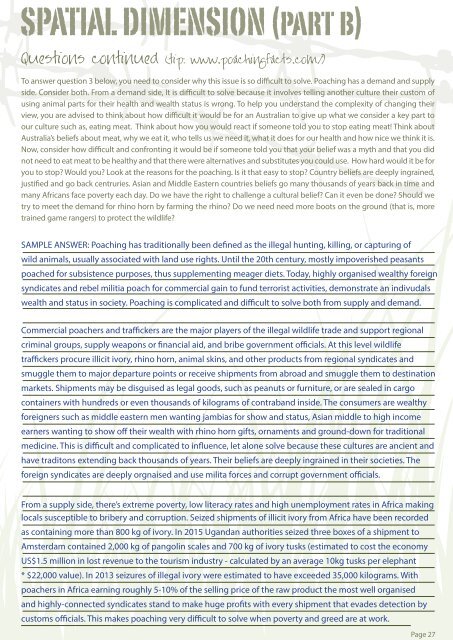Create successful ePaper yourself
Turn your PDF publications into a flip-book with our unique Google optimized e-Paper software.
SPATIAL DIMENSION (part b)<br />
Questions continued (tip: www.poachingfacts.com/)<br />
To answer question 3 below, you need to consider why this issue is so difficult to solve. Poaching has a demand and supply<br />
side. Consider both. From a demand side, It is difficult to solve because it involves telling another culture their custom of<br />
using animal parts for their health and wealth status is wrong. To help you understand the complexity of changing their<br />
view, you are advised to think about how difficult it would be for an Australian to give up what we consider a key part to<br />
our culture such as, eating meat. Think about how you would react if someone told you to stop eating meat! Think about<br />
Australia’s beliefs about meat, why we eat it, who tells us we need it, what it does for our health and how nice we think it is.<br />
Now, consider how difficult and confronting it would be if someone told you that your belief was a myth and that you did<br />
not need to eat meat to be healthy and that there were alternatives and substitutes you could use. How hard would it be for<br />
you to stop? Would you? Look at the reasons for the poaching. Is it that easy to stop? Country beliefs are deeply ingrained,<br />
justified and go back centruries. Asian and Middle Eastern countries beliefs go many thousands of years back in time and<br />
many Africans face poverty each day. Do we have the right to challenge a cultural belief? Can it even be done? Should we<br />
try to meet the demand for rhino horn by farming the rhino? Do we need need more boots on the ground (that is, more<br />
trained game rangers) to protect the wildlife?<br />
SAMPLE ANSWER: Poaching has traditionally been defined as the illegal hunting, killing, or capturing of<br />
wild animals, usually associated with land use rights. Until the 20th century, mostly impoverished peasants<br />
poached for subsistence purposes, thus supplementing meager diets. Today, highly organised wealthy foreign<br />
syndicates and rebel militia poach for commercial gain to fund terrorist activities, demonstrate an indivudals<br />
wealth and status in society. Poaching is complicated and difficult to solve both from supply and demand.<br />
Commercial poachers and traffickers are the major players of the illegal wildlife trade and support regional<br />
criminal groups, supply weapons or financial aid, and bribe government officials. At this level wildlife<br />
traffickers procure illicit ivory, rhino horn, animal skins, and other products from regional syndicates and<br />
smuggle them to major departure points or receive shipments from abroad and smuggle them to destination<br />
markets. Shipments may be disguised as legal goods, such as peanuts or furniture, or are sealed in cargo<br />
containers with hundreds or even thousands of kilograms of contraband inside. The consumers are wealthy<br />
foreigners such as middle eastern men wanting jambias for show and status, Asian middle to high income<br />
earners wanting to show off their wealth with rhino horn gifts, ornaments and ground-down for traditional<br />
medicine. This is difficult and complicated to influence, let alone solve because these cultures are ancient and<br />
have traditons extending back thousands of years. Their beliefs are deeply ingrained in their societies. The<br />
foreign syndicates are deeply orgnaised and use milita forces and corrupt government officials.<br />
From a supply side, there’s extreme poverty, low literacy rates and high unemployment rates in Africa making<br />
locals susceptible to bribery and corruption. Seized shipments of illicit ivory from Africa have been recorded<br />
as containing more than 800 kg of ivory. In <strong>2015</strong> Ugandan authorities seized three boxes of a shipment to<br />
Amsterdam contained 2,000 kg of pangolin scales and 700 kg of ivory tusks (estimated to cost the economy<br />
US$1.5 million in lost revenue to the tourism industry - calculated by an average 10kg tusks per elephant<br />
* $22,000 value). In 2013 seizures of illegal ivory were estimated to have exceeded 35,000 kilograms. With<br />
poachers in Africa earning roughly 5-10% of the selling price of the raw product the most well organised<br />
and highly-connected syndicates stand to make huge profits with every shipment that evades detection by<br />
customs officials. This makes poaching very difficult to solve when poverty and greed are at work.<br />
Page 27



